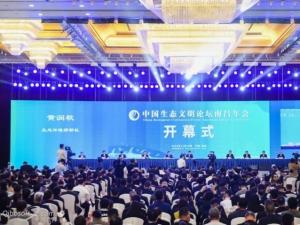Anna Achleitner:Post Growth as an Approach towards Environmental Justice
|
Anna Achleitner This article aims at reconsidering our current growth-lead attitude and lifestyle. “The Limits to Growth” commissioned by the Club of Rome is the most influential and most discussed publication questioning the continuous economic growth. In recent years the discussion on sufficiency and post growth approaches has got more and more widespread and vivid. Since the beginning of industrialization the idea and the aim of economic growth has been central to society and politics. Advocates of this paradigm claim that growth is the best option to achieve distributive justice and high living standards. However, decades of successful growth and plenty of attempts to lead the economy in the direction of efficiency and circularity have neither led to decoupling growth from environmental degradation nor to increasing global justice. Maybe the problem of lacking sustainability cannot be solved by changing the patterns of our current growth-based system but has to be approached by avoiding its causes. A concept of sustainability only considering options added to current structures and not taking into account the possibility to subtract or to avoid some elements, is not complete (Paech 2005: 68). Thus, the option of a shift off the path of continuous growth shall be part of discussions in politics, science and economics nowadays. Global Environmental Justice Climate change and other environmental damages are threatening intra- and intergenerational justice. Industrialization in developed countries has caused tremendous pollution, the resulting wealth and the consequences of environmental degradation are in most cases not equally distributed. The most prominent example on a global scale is climate change: Economic growth was achieved by emitting high amounts of GHG emissions, long time before the consequences of these emissions have been known. Many people in developing countries are already facing the impacts of climate change. Droughts, shrinking lakes and a lack of drinking water, floods and melting glaciers have become reality in many places. According to scientific research this is happening due to the carbon intensive lifestyle of people living in the industrial countries. Therefore and as poor people do not have the capacity to successfully adapt to these environmental changes, the discussion on climate change is also a question of social justice (Eins Entwicklungspolitik 2007). It is clear that climate change will exacerbate both poverty and inequality. The poorest will be hit first and hardest by climate change even though they have contributed least to the problem. Preventing dangerous climate change is essential if we hope to eradicate poverty (Greenpeace International 2009). Fuhr and Spiller (2010) emphasize that a solution has to include more than Green Economy in the North and low-carbon development in the South. The issue of climate change once again questions the current global power relations. Fuhr and Spiller doubt that the necessary change can happen within the current social system. Recap of the Literature on Global Justice A range of concepts on how intergenerational and intragenerational justice can be determined or measured have been provided. A very widespread concept of equality was introduced by Adam Smith and the classical economics before Marx and Keynes. They assumed that free markets lead to maximum balance and therefore to social justice (Schmid 2007: 89f). Closely related to that is utilitarian welfarism, which is based on the idea that income and commodities provided by the economy lead to happiness. Its aim is to produce the maximum happiness among the majority of people (Muraca 2012: 537). Egalitarianism is concerned about the equal distribution of resources, it only justifies inequalities if they benefit the least advantaged members of society (ibid: 538). Sen offers a very different approach emphasizing that “goods are valuable only if people value them” (ibid: 538) and addresses an essential thought of the degrowth discussion. Green Economy The first anti-growth movement of the 1970s was rejected by pro-growth green capitalism. Advocates of eco-capitalism argue that “green technology, green taxes, green labeling, eco-conscious shopping and the like could ‘align’ profit-seeking with environmental goals” (Smith 2011: 112). One of the most influential theorists in this epoch was Paul Hawken, who published his bestseller “Ecology of Commerce” in 1993. Hawken states that business is destroying the world, he doesn’t blame capitalism as such for the damage but says that the way of doing business has to be changed. Eco-capitalists do not see the solution to ecological and social issues outside the free market system, they rather suggest including these issues in the market prices (Smith 2011: 113f). Closely related to these ideas is the Kuznets Curve (1955 by Simon Kuznets), which suggests that income inequality naturally increases during the initial development of an economy and starts to decrease at a certain level of average income. 1991 Grossman and Krueger published their observation that some pollutants follow the same time pattern as described by Kuznets (Levinson 2000). Growth advocates therefore claim that with a continuously increasing GDP social inequalities as well as environmental degradation are going to be minimized. Looking at the improving environment of rich countries outsourcing their dirty industries to countries like China with lower per capita income and increasing pollution, the curve seems to perfectly match the current situation.Even though the concept is subject to criticism, it is fundamental to global environmental politics. The finding that the environment will be fine even without refraining from business as usual is a convenient reason to lean back when commitments in favor of environmental protection are asked and to justify the interest in further economic growth (Stern 2004: 1419f). Evidence has shown “that developing countries are addressing environmental issues, sometimes adopting developed country standards with a short time lag and sometimes performing better than some wealthy countries” (ibid: 1419). Furthermore, Stern finds that the statistical foundation of the EKC concept is very weak and that data, proving that all countries develop along the inverted U-curve to an advanced economy with high income and low environmental pollution, is lacking (ibid: 1435). The German Environment Advisory Council has shown that the EKC is only valid in some special cases and cannot be generalized based on the available scientific research so far (Muraca 2012: 540). Since the 1980s “green”and “sustainable”have become the key ideas of mainstream economy. Organic food, renewable energy and ecological travelling determine the new lifestyle in developed countries (Smith 2011: 115). Investments in anything that’s green are highly recommended to achieve the Green Economy’s aim of keeping up growth and at the same time significantly reducing greenhouse gases and any other environmental damages. According to the UNEP green economy is “one whose growth in income and employment is driven by public and private investments that reduce carbon emissions and pollution, enhance energy and resource efficiency, and prevent the loss of biodiversity and ecosystem services” (UNEP 2012). Green capitalism is gaining high popularity; initiatives for climate protection are launched with the main intention to make money, issues like climate change and pollution are only of secondary importance. New York Times’columnist Thomas Friedman said that further growth could be achieved by moving to clean, renewable energy sources. He claims that global development to North American living standards could be assured (Smith 2011: 124). However, as Smith argues, green economy is better than a dirtier way of doing business and the need for environmental protection has been acknowledged by politicians all over the world. The first carbon tax system was introduced in Finland in 1990 and many countries and regions from provinces in Canada and the USA to South Africa, South Korea and some European countries followed (Smith 2011: 115). Today many countries have introduced a mix of political and economical mechanisms to achieve green growth. Economic Growth vs. Environmental Justice One fundamental issue with economic growth as the solution to environmental degradation and increasing social inequalities is that the capitalist model itself is the source of the ecological crisis. Furthermore, our planet with its limited resources cannot sustain infinite growth and exploitation. Isn’t it naïve to trust solely oncontinuoustechnical advancementwhile we are already confronted with the destructive outcome of several decades of high polluting industrialization– no matter if we talk about climate change or “only” the destruction of rainforests and the like?As Paech argues, immense investments in technology and stunning outcomes have not lead to decoupling growth from environmental degradation so far. Furthermore, many suggestions for technical innovation are depending on new materials leading to further pollution (Paech 2005: 53, 68). Green growth economists like Sir Nicolas Stern argue that a minimal cost of only some percent of economic growth is needed to tackle climate change (Smith 2011:124). Qualitative growth means renewables instead of oil, gas and coal, electronic cars and energy efficient buildings. Economists talk about a win-win situation as both, growth and solving the ecological crisis can be achieved at the same time (Loske 2011). These ideas are opposed by scientists, who show that continuous growth is unsustainable and the climate problem cannot be solved without “large scale reductions in the volumes of economic production and consumption taking place” (Trainer, cited in Smith 2011: 124). Loske acknowledges the necessity of qualitative growth strategies but emphasizes that at the same time limitations in absolute resource consumption have to be made. This needs political solutions, technological innovation and a structural change of lifestyle in industrial countries at the same time (Loske 2011). Subsequently some further arguments, why market-based solutions and strategies aiming at continuous growth can neither lead to climate change mitigation, nor to global justice, are summarized: Where companies are responsible to the interests of private owners and shareholders rather than to society, CEOs might aim at protecting the environment as long as this is combinable with capital accumulation. In capitalism profit maximization will not be subordinated to environmentalism and global social justice, because this would lead to mayor troubles like shareholder flight (Smith 2011: 116). Economic growth is based on consumerism. “[…] in a competitive market system […] capitalists, workers, consumers and governments alike are all locked into an endless cycle of perpetually increasing consumption to maintain profits, jobs and tax revenues. We can’t shop our way to sustainability because the problems we face cannot be solved by individual choices in the marketplace. […]They require national and international cooperation and global economic planning, […] [which] presupposes a global redistribution of wealth as well.” (Smith 2011: 117) The attempt of an international agreement for greenhouse gas reduction failed because of the countries’ economic interests. If a country decides to commit to any environmental obligations while other countries do not, it will lead to economic disadvantage and cause a significant GDP fall (Smith 2011: 118). The problem with “cap and trade” and carbon tax is, that in a global market, single country governments will not put significant taxes or emission caps on their own industries as this would threaten their competitiveness and cause economic disadvantages (ibid). The Clean Development Mechanism under the Kyoto Protocol allows countries with binding commitments to implement emission reduction projects in developing countries and earn certified emission reduction credits (UNFCCC 2012). It is mainly criticized for lacking efficiency of many approved projects (Lütken 2011). Furthermore, the WWF notes that loopholes in the CDM and the European Emission Trading Scheme “allow companies to avoid paying for the greenhouse gas pollution they cause and to use fake carbon offsets” (WWF EPO 2010). Even though renewable energy sources are clearly favored over fossil fuels and nuclear energy, they as well have limitations of exploitation. Biomass needs immense areas and therefore vies with food production for land and tends to cause pure plantation and deforestation. Also in case of waterpower the potential for environmental damage and destruction of peoples’ living areas has to be taken into consideration. Thus, also with a transition to renewable energy sources and new technologies infinite growth is far from being a sustainable option (Loske 2011). The trickle-down effect or the metaphor “a rising tide lifts all the boats” claims that also the poorest people in society will sooner or later benefit from economic growth. These arguments have been disproven with studies showing that the social gap rather broadens than narrows with increased growth rates (Xue 2011: 87). As Daly noticed, even the comparison with the effect of a tide is wrong as “a flood in one part of the world requires low tide on the other side” (Daly 2001: 15). Non-growth-based Approaches - the Discussion in Europe The idea of post-growth, degrowth or moving away from capitalist profit maximization towards sufficiency shall be discussed as an alternative choice to the current economic patternsand will be examined towards itspotential for environmental justice in the following. Advocates of the post-growth sufficiency approach just do not believe that permanent growth and increasing production can cause the environmental protection necessary for ensuring intra- and intergenerational justice (Loske 2011). The problem about the efficiency approach is, that it is still based on the target of economic growth, so that the positive influence of technical innovation on the environment is wiped off by effects of growth. This means, resources saved by using more efficient cars or electronic devices is neutralized as there are more cars, bigger cars and more different kinds of electronic devices (ibid). Post-growth calls for a cultural transition towards sufficiency, moderation and deceleration. These arguments are supported by recent science of social welfare and happiness, which examines the correlation between GDP and wellbeing. It shows that beyond a certain income covering basic needs, there is no relation between money and happiness. The continuous striving for capital maximization has been proven to be rather dissatisfying (Loske 2011). The European discussion on non-growth-based economic systems can roughly be divided into several different ideas. The European de-growth movement in France, Italy and Spain was mainly inspired by Georgescu-Roegen’s position that only a declining state is desirable and feasible (Kerschner 2010: 544). Georgescu-Roegen published his ideas on economic de-growth in the 1970s and was part of the first movement against the growth paradigm at that time. The goals of de-growth are social justice, ecological sustainability and well-being, the means to move towards these targets is reducing consumption and production. Because of today’s overconsumption in industrial countries and the limits of natural resources advocates of de-growth are convinced that a period of economic decline is imminent. Thus, they do not argue if de-growth is going to happen, but how to handle avoiding collapse of society and the environment. The de-growth vision includes re-localization, fairer distribution of income and resources, sufficiency and innovation (SERI 2012: 34f; Humburg 2011: 14ff). Another approach is based on the US-American scientist Herman Daly, who has developed the steady-state economic model. It is a vision of an economy that reached an optimal level with sustainable consumption and constant population (SERI 2012: 31). This steady-state economy is characterized by a constant physical capital stock and constant population. Daly suggests the implementation of institutions to assure these preconditions for sustainable development. He furthermore argues for an institution to keep distributive justice between different groups in society. His ideas are based on the current system of private property and market economy (ibid). The third group to be differentiated argues for a post-growth society, in which the economy is independent from growth. This idea is mainly based on the “Limits of Growth” and has enjoyed more attention in scientific discussions in recent years. Proponents argue that growth is not a solution anymore and has rather become part of the problem. The welfare model of the West cannot be conferred to the rest of the world, therefore another concept of welfare is necessary. (SERI 2012: 37f). Post-growth does neither expect standstill, nor does it mean de-growth, it rather encompasses both ideas and suggests an economy and society that is not based on growth as the main factor for development and well-being. A representative of post-growth economy is Niko Paech, who, together with Werner Onken, offers a platform for academic discussion for social and economical change to an era after our current growth centered lifestyle.[①]According to Paech, the main structures of a post-growth society include clearance of unusable goods, getting rid of any burdens that need time, money, space and resources but are only of low value in the end. Furthermore characteristics are a balance between sufficiency and dependence on external goods, regional economy, maintenance and reuse and institutional innovation including reform of land and money (Paech 2012). In all these approaches social justice and environmental protection prevail as goals to economic development, which stands in contrast to the ‘Green Economy’ where maximizing profits is the overall target. However, they do not describe any model of a just society that should be reached and lack concrete steps for implementation of a post-growth policy. As mentioned above the current economic level in industrial countries has already passed the sustainable level of economic activity suggested by Daly. Therefore de-growth is the way to get there in some regions. I agree with Kerschner, that the two models of de-growth and steady-state complement each other. A steady state might not be enough to achieve global justice and the de-growth model still lacks suggestions of implementation, the post-growth debate offers the right platform to advance these concepts. Daly’s model is based on ideas rooted in the historical scientific discussion on economic development and offers concrete policy proposals. The de-growth movement and literature contributes with their bottom-up approach and grass-root initiatives which are necessary to include the society in the discussion on ways to achieve social and environmental justice (Kerschner 2010: 549). Is Post Growth relevant to China? Chinais being confronted with a wide range of environmental threats caused by industrial pollution of water, air and soil. Also the impact of rising temperatures can already be felt, there are droughts in northern China and floods caused by glacial melt and heavy rainfall in the south. Similar to the global situation, the poorest groups of the Chinese population that depend on the land and the climate are hit hardest by the impact of growth-led development in the rich regions. Furthermore, as Xue et. al. (2012: 91f) suppose, the discussion in western countries “could inspire reflection on the economic growth of China as a whole”. The growth-based policy over the last thirty years has improved living standards of a great part of the Chinese population, instead of trickling down to the least developed regions of the country, inequalities have been enforced. According to the Gini coefficient, which measures overall inequality, China counts now as one of the most unequal countries worldwide (with an increased Gini from 0.29 to 0.44 over the period 1981 to 2004) (ibid). Despite immense growth rates since 1970, other social aspects like education and health lack behind. According to the UNDP (2010) school enrollment rates have declined compared to 1970. Concerning environmental pollution, the Chinese government started comparatively early to include these issues in their development strategies (Xue et.al. 2012: 93). Since science started to provide evidence for the correlation between carbon emissions and increasing temperatures in the 1990s (PIK et.al. 2010: 11), international efforts are necessary and China as a large country in transition has been urged to take action at an early stage of development. However, in practice also in China environmental sustainability is subordinated to the aim of economic growth. Studies applying the EKC hypothesis to the Chinese context have shown that “the relationship between income growth and environmental quality is more complex than the hypothesized inverted U-shaped curve” (Xue et.al. 2010: 93). China’s ambitious environmental policies have been outweighed by the destructive impacts of economic growth. Xue et.al. (2010: 94) mention China’s dilemma as the country with the largest population. China has a low per capita consumption level which is a reasonable explanation for the need of further economic growth. In regard to carbon emissions, China overtook the USA as the world’s biggest emitter in 2007, calculating in per capita the country’s emissions are still below the world average (Rommeney 2008:3). Also in case of aggregate consumption China ranks high with its large population. Xue et.al. mention the example that “an increase in China’s per capita consumption of four major industrial metals (steel, aluminum, copper and lead) to the present standard in developed countries would approximately double the world’s use of these resources” (Xue et.al. 2010: 94). Thus, it is necessary that China and other developing countries take part in a discussion on decreasing overall consumption and keeping it at a level below business as usual. In the case of China the western discussion on moving past a growth based economic model can be inspiring for the efforts to solve the problem of high inequality between various regions on the one hand and immense pollution resulting from growth driven industrialization on the other hand. According to Xue et. al. (2010: 103) for China - and similarly on a global scale - the main aspects to assess are “growth for how long, growth for whom, and growth for what”. Even if developing countries still have the moral right to growth, they cannot ignore the fact that due to the limited capacity of our environment going the same growth based path of industrial countries is not an option. However, they do have the right to expect developed countries to step ahead setting up a new model (ibid: 104). Conclusion For a long time continuous economic growth seemed to lead to higher living standards and social safety but it has been proven that only some parts of the society profit from growth and ideas, like the trickle-down effect, have been refuted. Successful sustainable policy measures have to lead towards abatement of the urge and enforcement to growth and capital maximization. The models of de-growth and steady-state have to be reassessed for a country’s or region’s specific situation and are options at the end of the road of transformation. The post-growth approach demands the alignment of economic activity with the targets of environmental protection and social justice. This is a fundamental contrast to the current growth based approach. It would cause the end of affluence and lead towards more environmental justice. The problem of post-growth and sufficiency strategies is that they do not offer any convincing and inspiring social theory or model. Post-growth approaches mainly consist of criticism on the current system and call for individual measures and change of lifestyle (Loske 2011). “We need instruments that comprehensively define social welfare as interplay of economical, ecological and social factors and decouple it from mere growth” (ibid). Loske furthermore remarks that this road of a fundamental cultural transformation is not an easy task and requires a lot more efforts than a Green Economy simply based on technical innovation and efficiency but emphasizes its necessity (ibid). Literatur Eins Entwicklungspolitik(2007): Dossier: Klimawandel und Gerechtigkeit. Retrieved 06 November 2012 from <http://www.klima-und-gerechtigkeit.de/fileadmin/upload/Publikationen/eins_17-18-07_Dossier.pdf> Fuhr, Lili & Spiller, Ingrid (2010): Ein Schritt vor und zwei zur Seite. Retrieved 07 October 2011 from <http://c1.hbs.boell-net.de/oekologie/klima/klima-energie-analyse-klimagipfel-cancun-10814.html> Greenpeace International(2009): Equity and Climate Action: Greenpeace Positon. Retrieved 03 October 2011 from <http://www.greenpeace.org/international/Global/international/planet-2/report/2009/5/equity-and-climate-action.pdf> Humburg, Anja (2011): Post-Growth on the Move. The Environmental Movement as Agend of Change for the Transition to a Post-Growth Economy – Evidence from Germany. Master thesis, Lund University. Retrieved 5 November 2012 from <http://www.lumes.lu.se/database/alumni/09.11/Thesis/Humburg_Anja_Thesis_2011.pdf> Kerschner, Christian (2010): Economic de-growth vs. steady-state economy. Journal of Cleaner Production 18 (2010), 544 – 551 Levinson, Arik (2000): The Ups and Downs of the Environmental Kuznets Curve. Retrieved 5 November 2012 from <http://harbaugh.uoregon.edu/Readings/Environmental/Levinson,%202000,%20EKC%20ups%20and%20downs.PDF> Loske, Reinhard (2011): Jenseits con “Green New Deal” und Effizienzrevolution. Droht in der Wachstumsdebatte ein grünes Schisma? Retrieved 29 October 2012 from <http://www.postwachstumsoekonomie.org/Loske_Jenseits_von_Green_New_Deal.3.pdf> Lütken, Søren E. (2011): Indexing CDM distribution: Leveling the playing field. Capacity Development for the Clean Development Mechanism, Working paper No. 10. Retrieved 29 January 2012 from <http://www.cd4cdm.org/Publications/IndexingCDMdistribution.pdf> Muraca, Barbara (2012): Towards a fair degrowth-society: Justice and the right to a ‚good life’beyond growth. Futures 44 (2012), 535 – 545. Retrieved 7 November 2012 from <http://www.sciencedirect.com/science/article/pii/S0016328712000560> Paech, Niko (2005): Nachhaltigkeit zwischen ökologischer Konsistenz und Dematerialisierung: Hat sich die Wachstumsfrage erledigt? Natur und Kultur 6/1, 52 – 72 Paech, Niko (2012): Grundzüge einer Postwachstumsökonomie. Retrieved 6 November 2012 from <http://postwachstumsoekonomie.org/html/paech_grundzuge_einer_postwach.html> Potsdam-Institut für Klimafolgenforschung (PIK)et al. (2010): Global aber gerecht. Klimawandel bekämpfen, Entwicklung ermöglichen. München: C.H.Beck Schmid, Tom (2007): Gleichheit und Gerechtigkeit – zwei aufeinander bezogene Begriffe. In: EQUAL-Entwicklungspartnerschaft QE GM (Hg.): Qualitätsentwicklung Gender Mainstreaming, Band 2: Grundlagen. Horn: Druckerei Berger, p. 83 – 108. Retrieved 14 September 2011 from <http://www.qe-gm.at/produkte/downloads/qe-gm_Band2_Grundlagen.pdf> Smith, Richard (2011): Green Capitalism: the god that failed. Real world economics review, Vol. 56, 112 – 144 Stern, David I. (2004): The Rise and Fall of the Environmental Kuznets Curve. World Development Vol. 32/8, 1419-1439. Retrieved 7 November 2012 from <http://steadystate.org/wp-content/uploads/Stern_KuznetsCurve.pdf> Sustainable Europe Research Institute (SERI): Zukunftsdossier: Wirtschaften jenseits von Wachstum. Befunde und Ausblicke. Reihe ‚Zukunftsdossiers’, Vol.1. Retrieved 5 November 2012 from <http://www.wachstumimwandel.at/wp-content/uploads/Wirtschaften-jenseits-Wachstum_korrektur_2.pdf> United Nations Environment Programme (UNEP) (2012): What is the "Green Economy"? Retrieved 31 October 2012 from http://www.unep.org/greeneconomy/AboutGEI/WhatisGEI/tabid/29784/Default.aspx United Nations Environmental Program(UNEP) & United Nations Framework Convention on Climate Change (UNFCCC) (1999): Klimaänderungen besser verstehen. Ein Leitfaden für Anfänger zur Klimakonvention der Vereinten Nationen und zu Protokol von Kyoto. Retrieved 30 October 2011 from <http://unfccc.int/cop5/klima/begger/begger.pdf> United Nations Framework Convention on Climate Change(2012): Essential Background. Retrieved 29 January 2012 from <http://unfccc.int/essential_background/items/6031.php> WWF European Policy Office(EPO) (2010b): ETS credibility at stake as industrial polluters profit yet again. Retrieved 10 October 2011 from <http://www.wwf.eu/climate/news_climate/?197955/ETS-credibility-at-stake-as-industrial-polluters-profit> Daly, Herman (2001): Unwirtschaftliches Wachstum und Globalisierung in einer vollen Welt. In: Natur und Kultur, Vol. 2/2 (2001), 3 – 22 Xue, Jin et.al. (2012): Is the degrowth debate relevant to China? In: Environment, Development and Sustainability, Vol. 14/1, 85-109 United Nations Development Program(UNDP) (2010): Human development report 2010: 20th Anniversary Edition. Potsdam-Institut für Klimafolgenforschung(PIK) et al. (2010): Global aber gerecht. Klimawandel bekämpfen, Entwicklung ermöglichen. München: C.H.Beck Rommeney, Dirk (2008): Climate and Energy Policy in the Peoples Republic of China. An Overview concerning Chinese Domestic Laws, and the Instruments and Measures of Climate Change Mitigation. Beijing: Heinrich Böll Foundation |
我来说两句
已有0评论 点击全部查看






